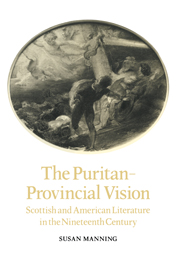Book contents
- Frontmatter
- Contents
- Preface
- Acknowledgements
- 1 Calvin's theology and the puritan mind
- 2 After Armageddon: Jonathan Edwards and David Hume
- 3 From puritanism to provincialism
- 4 The pursuit of the double
- 5 Spectators, spies and spectres: the observer's stance
- 6 ‘Is anything central?’
- Notes
- Bibliography
- Index
3 - From puritanism to provincialism
Published online by Cambridge University Press: 21 January 2010
- Frontmatter
- Contents
- Preface
- Acknowledgements
- 1 Calvin's theology and the puritan mind
- 2 After Armageddon: Jonathan Edwards and David Hume
- 3 From puritanism to provincialism
- 4 The pursuit of the double
- 5 Spectators, spies and spectres: the observer's stance
- 6 ‘Is anything central?’
- Notes
- Bibliography
- Index
Summary
Edwards’ great millstone and rock
of hope has crumbled, but the square
white houses of his flock
stand in the open air,
out in the cold,
like sheep outside the fold.
Hope lives in doubt.
Faith is trying to do without
faith. In western Massachusetts,
I could almost feel the frontier
crack and disappear.
Edwards thought the world would end there.
(Robert Lowell)Adam Smith (Hume's friend and another Scot of Calvinist background) is not a writer of Hume's complexity, but his first book, The Theory of Moral Sentiments (1759), develops the concepts of sympathy and of the ‘impartial spectator’ in ways which simultaneously reaffirm their connection with Calvinism and extend their literary possibilities as ‘noncentral’ ways of looking at the world.
Adam Smith took a broader view of sympathy than Hume: he defined it as ‘our fellow-feeling with any passion whatever’, and synonymous with ‘humanity’ – which thereby became passive and re-active, rather than vital and initiatory, although its demands on the individual were irresistible. Sympathy was a social bond: spectators placed themselves in the situation of the actor or sufferer and shared in his emotions, and the agent had his emotions modified by sympathising with the spectators and imagining how he would feel if he too were watching his own actions (p.22). Smith saw these sympathetic ties as the basis of moral judgement; they became the criteria for participation in or exclusion from the community.
- Type
- Chapter
- Information
- The Puritan-Provincial VisionScottish and American Literature in the Nineteenth Century, pp. 47 - 69Publisher: Cambridge University PressPrint publication year: 1990



